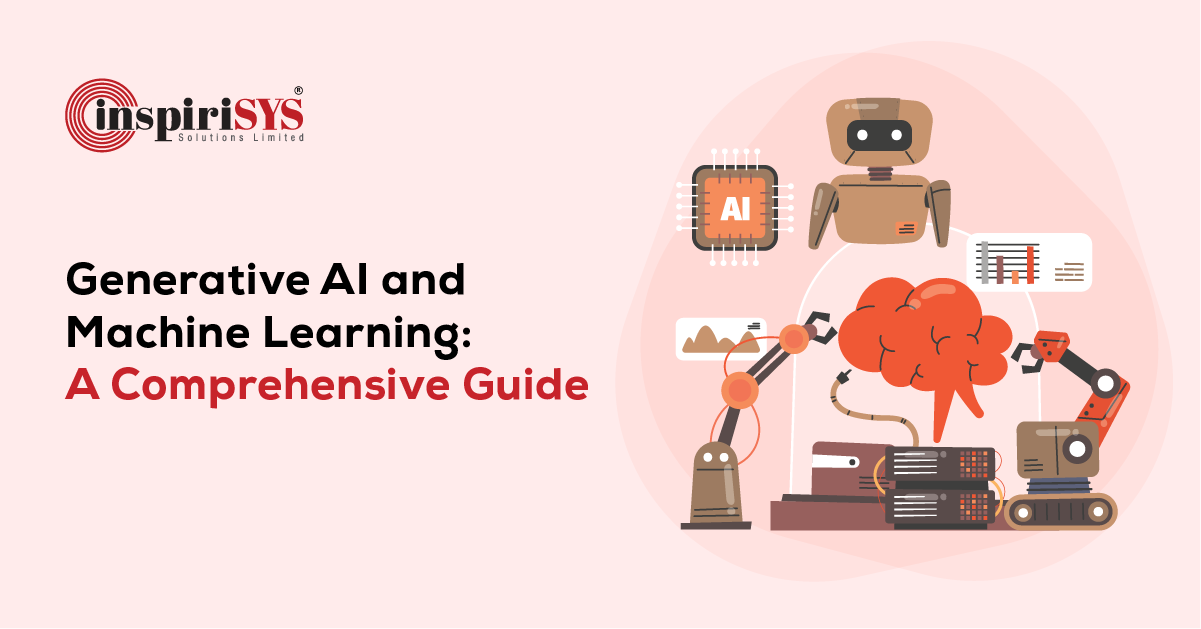Quick Summary: Discover the transformative potential of Generative AI and Machine Learning as we delve into their innovative applications, tools, and the future they shape in technology and beyond.
Imagine waking up to a world where you are greeted not by the chirping of birds, but by robots. As you step into the kitchen, you can enjoy various flavors of your choice prepared by robotic assistants. Meanwhile, other robots clean your rooms. Outside, the streets are filled with driverless vehicles navigating through the beautiful landscape. In the classrooms, robotics buzz with activity, and children play with robots on the playground. As you relax in the evening, you can smell the aroma of tea made by the chief robot. This is a life filled with artificial intelligence. And you know what? Such a life is not far from reality. Yes, you heard it right!
In the ever-changing world of technology, artificial intelligence is engulfed by the world unexpectedly. It is pushing the boundaries of what's possible, and here stand the two powerful tools: Generative AI and Machine Learning. Generative AI creates new content such as images, text, music, and even code by learning from vast amounts of existing data. On the other hand, machine learning, a subset of AI, focuses on developing algorithms that enable systems to learn from data and make decisions. Generative AI and Machine Learning are creating a future filled with exciting possibilities. Let's delve and uncover how these advancements are reshaping our world.
So, what does Traditional AI mean?
Traditional AI, the initial stage of AI development, relies heavily on programming. Human experts create algorithms and rules written in code to instruct machines on how to perform specific tasks. Web search engines and platforms like Netflix, YouTube, Amazon, and Google utilize traditional AI. Let’s now take a look at real-life examples of traditional AI:
- Chess-playing Programs - These AI programs are designed with established algorithms to play against human opponents.
- Spam Filters in Email Services - The spam filtering system uses machine learning to analyze vast amounts of data continuously. This ongoing process refines its ability to identify and filter out spam emails. Techniques like Natural Language Processing (NLP) and sentiment analysis help the system understand and process emails, allowing it to segregate spam from important messages. This significantly reduces the chances of unwanted emails landing in your inbox.
- Threat Analysis - A wide array of data is gathered from evolving threats, enabling improved detection through continuous monitoring of networks, patterns, and trends.
- Virtual Assistants - AI virtual assistants are software programs that produce responses via text or voice. They combine analytics and cognitive computing, incorporating location details, user information, and past interactions to provide assistance.
According to a recent survey by Precedence Research, the Generative AI market, estimated at USD 10.79 billion in 2022, is projected to reach USD 118.06 billion by 2032, growing at a CAGR of 27.02%.
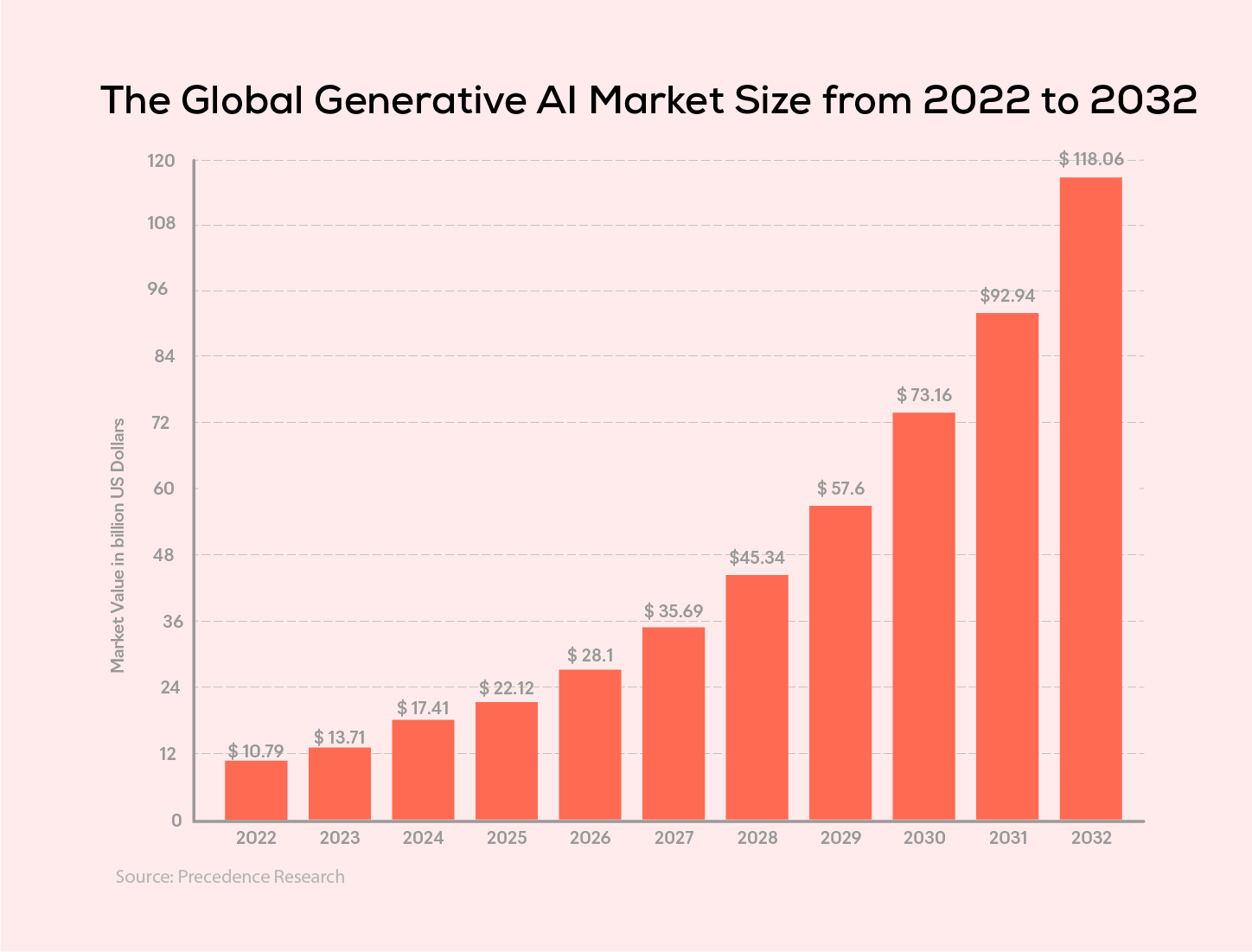
Working Process of Generative AI
Artificial intelligence gained popularity when the world of computers underwent a revolution. The past five years have seen significant advancements in natural language processing, leading to immense popularity. And that's not all. Generative models can learn the underlying structures of software code, natural images, rules, and grammar. New applications emerge daily, and the future holds exciting possibilities, thanks to the ever-expanding applications of AI.
Various techniques, such as neural networks and deep learning algorithms, are used to generate and identify patterns. This technology bridges the gap between machines and human creativity, allowing them to generate new ideas. The most used generative models are Generative Adversarial Networks (GANs) and Variational Autoencoders (VAEs).
In GANs, a dual machine learning model is used, consisting of two components: the generator and the discriminator. The generator is responsible for content creation. It uses the data it's trained on to invent new items that share similarities with the training data. On the other hand, the discriminator evaluates the generator's creations, determining whether they are real or fake. This feedback helps the generator improve its outputs, making them more realistic. GANs can be used to create brand-new, realistic images from scratch, alter the style of existing photos, and generate entirely new data that resembles the training data.
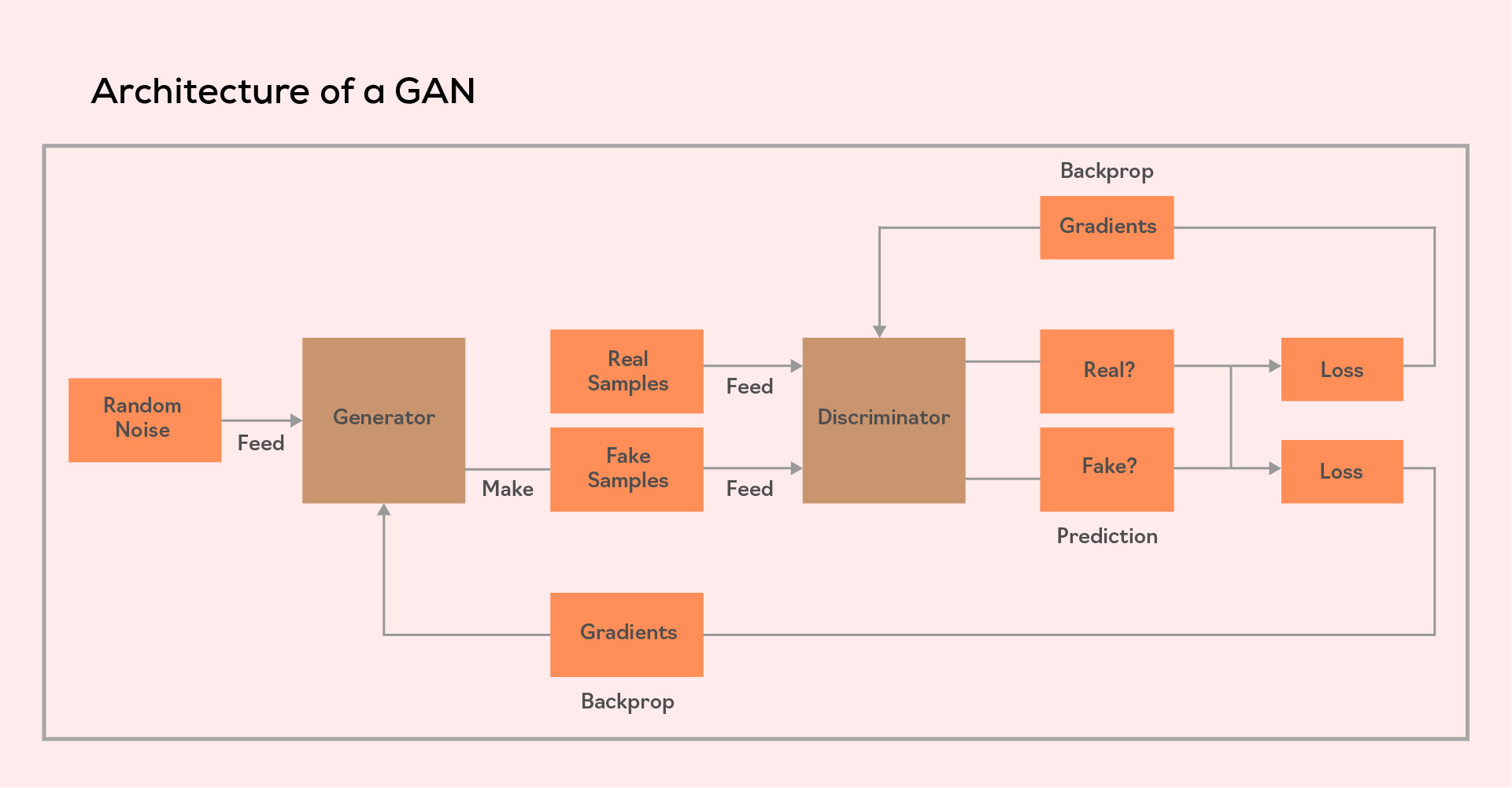
On the other hand, in VAEs, a single machine-learning model is trained to compress data into a lower-dimensional representation that captures the data's fundamental characteristics, dimensions, and structures. The model then reconstructs the original data from this lower-dimensional representation. This process of encoding and decoding enables the model to gain a comprehensive understanding of the data distribution, allowing it to produce new, similar outputs.
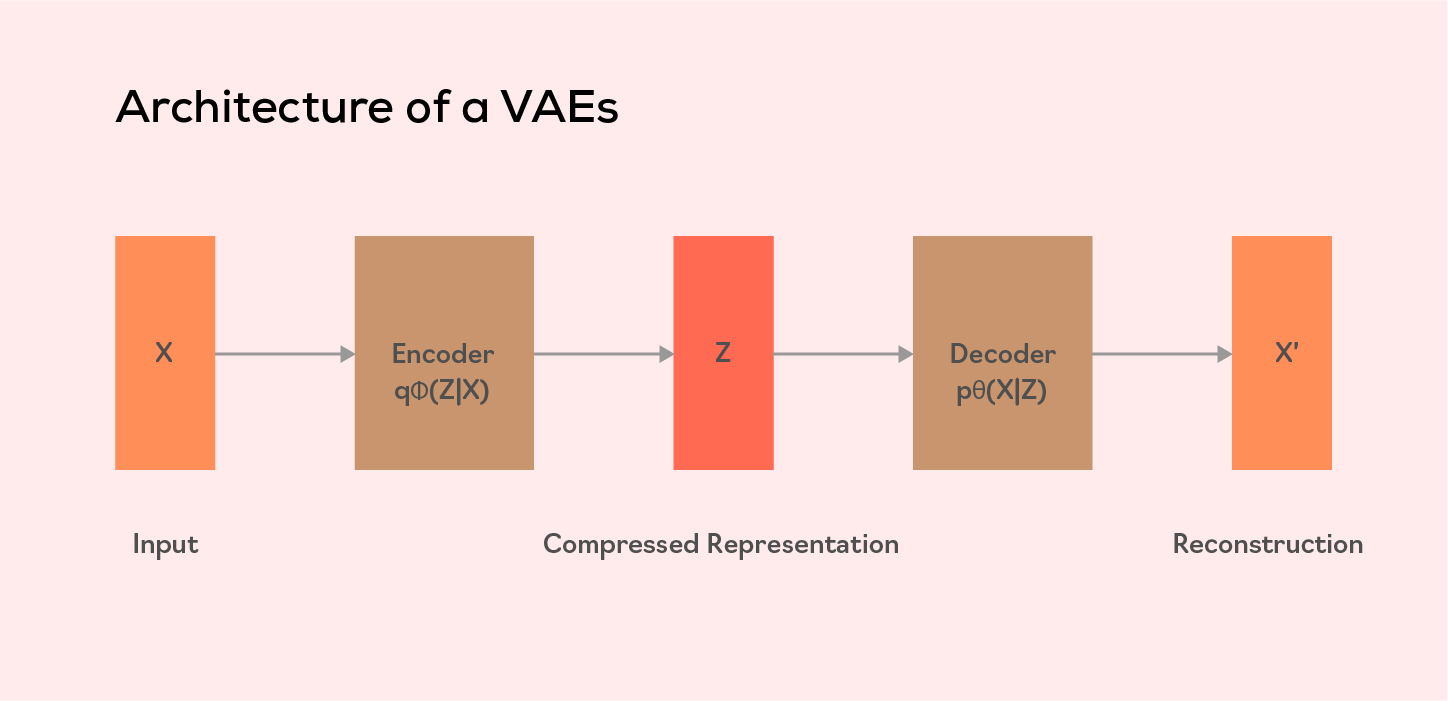
Real-World Applications of Generative AI
At present, generative AI plays an important role in both scientific discovery and technology. Generative AI is a game-changer, allowing you to create realistic images, text formats and images in just minutes. It offers a wide range of applications that can benefit numerous industries like healthcare, marketing, surveillance and even entertainment. Let's unveil one by one:
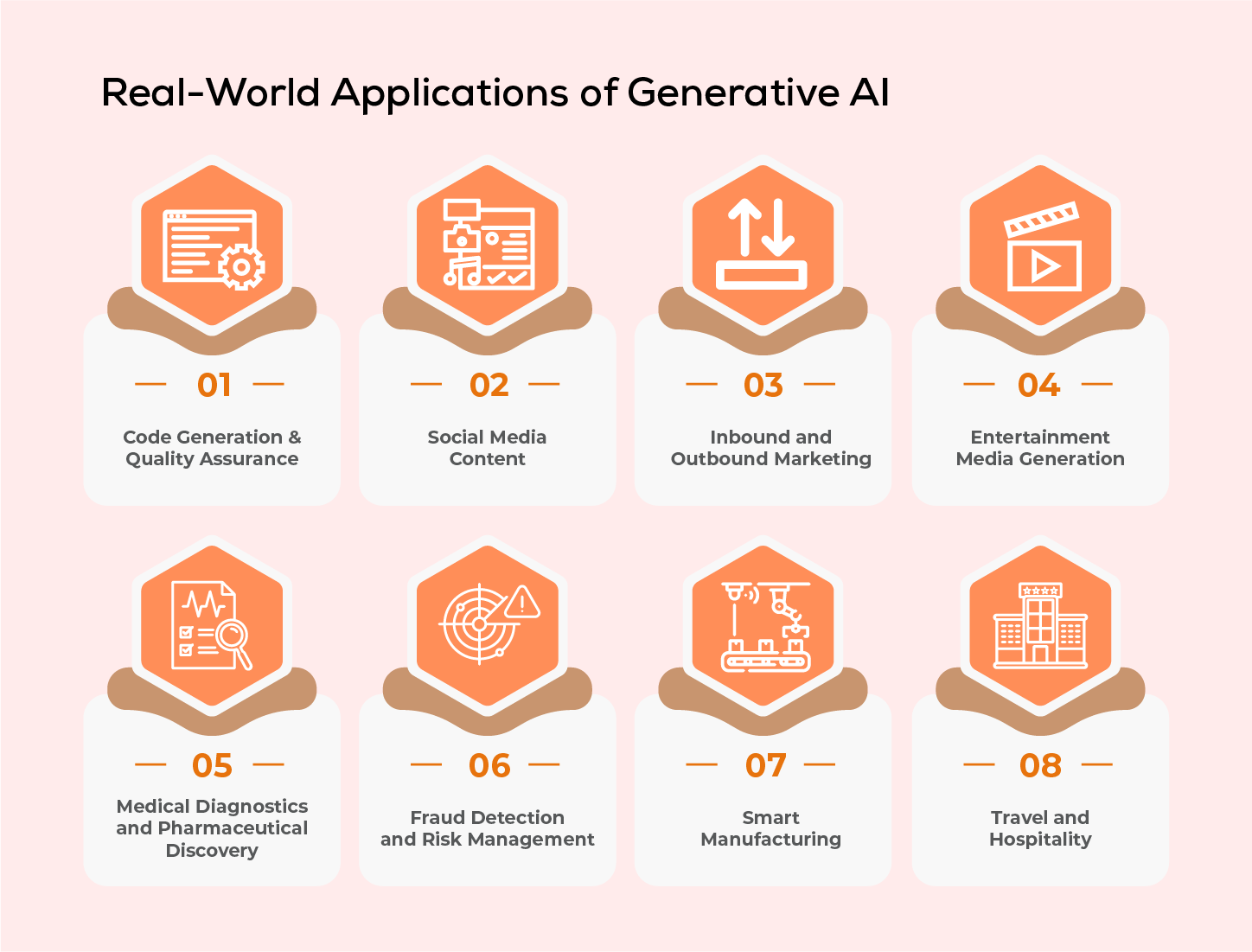
1. Code Generation and Quality Assurance
Generative AI can not only write new code and analyzing existing code to complete tasks but also generate test cases, identifying bugs, and automating documentation creation. These tools enable non-developers to write code by describing their requirements in natural language.
For example, Amazon’s CodeWhisper is a tool that generates pre-trained code snippets resembling what a human developer might write. It interprets natural language comments to generate code that aligns with the user's goals. Moreover, it provides suggestions to expedite task completion, enhancing the efficiency of coding processes.
2. Social Media Content
Large Language Models (LLMs) are invaluable for creating social media captions, blog posts, and other marketing materials. They can modify, shorten, or expand content, saving you time and effort. Based on given prompts, LLMs can generate entirely new and creative content, providing high-quality results. These AI writing tools allow you to control the tone and style of your writing. They can analyze your brand’s original content and incorporate your specifications to generate new content that resonates with your target audience.
Example: Stuck for ideas? Jasper is here to help! It produces high-quality content, from blog posts to social media updates. This tool understands your prompts and questions, assisting you with all sorts of content. Widely trained on diverse topics, Jasper provides insightful and accurate responses.
3. Inbound and Outbound Marketing
Generative AI tools can write engaging emails and chat messages for your campaigns, reaching out to potential customers. It can even automate moving contacts to the next stage in your CRM system, streamlining your customer lifecycle management. Generative AI tools can automate content creation, allowing teams to focus on personalized outreach that gets results.
Example - Hubspot AI tool generates fresh content, personalises campaigns and leverages in-depth data insights. It comes along with the features of outlining, drafting, rewriting and repurposing the content.
4. Entertainment Media Generation
How could one forget the Disney characters that have captivated the world? These iconic figures have sparked our imaginations, bringing characters to life in ways we never thought possible. But have you ever wondered how these characters were created? Yes, it was with the help of generative AI. As AI improves at creating realistic images, animations, videos, and audio, it’s being used for everything from movie graphics to inventing video game characters and delivering virtual reality experiences. This groundbreaking technology is propelling the media field to new heights of immersion like never before!
Gone are the days when people had to stand in front of a camera, film, and edit painstakingly. AI-powered tools now allow you to create realistic images in just hours.
Have you ever wondered how generative AI is playing a pivotal role in the Media and Entertainment Market? Here are some statistics to illustrate its impact!
The generative AI market in the Media and Entertainment sector is projected to reach USD 1,412.7 million by 2023, with a staggering CAGR of 26.3% expected between 2023 and 2032. By 2032, sales in this sector are expected to soar to USD 11,570.0 million.
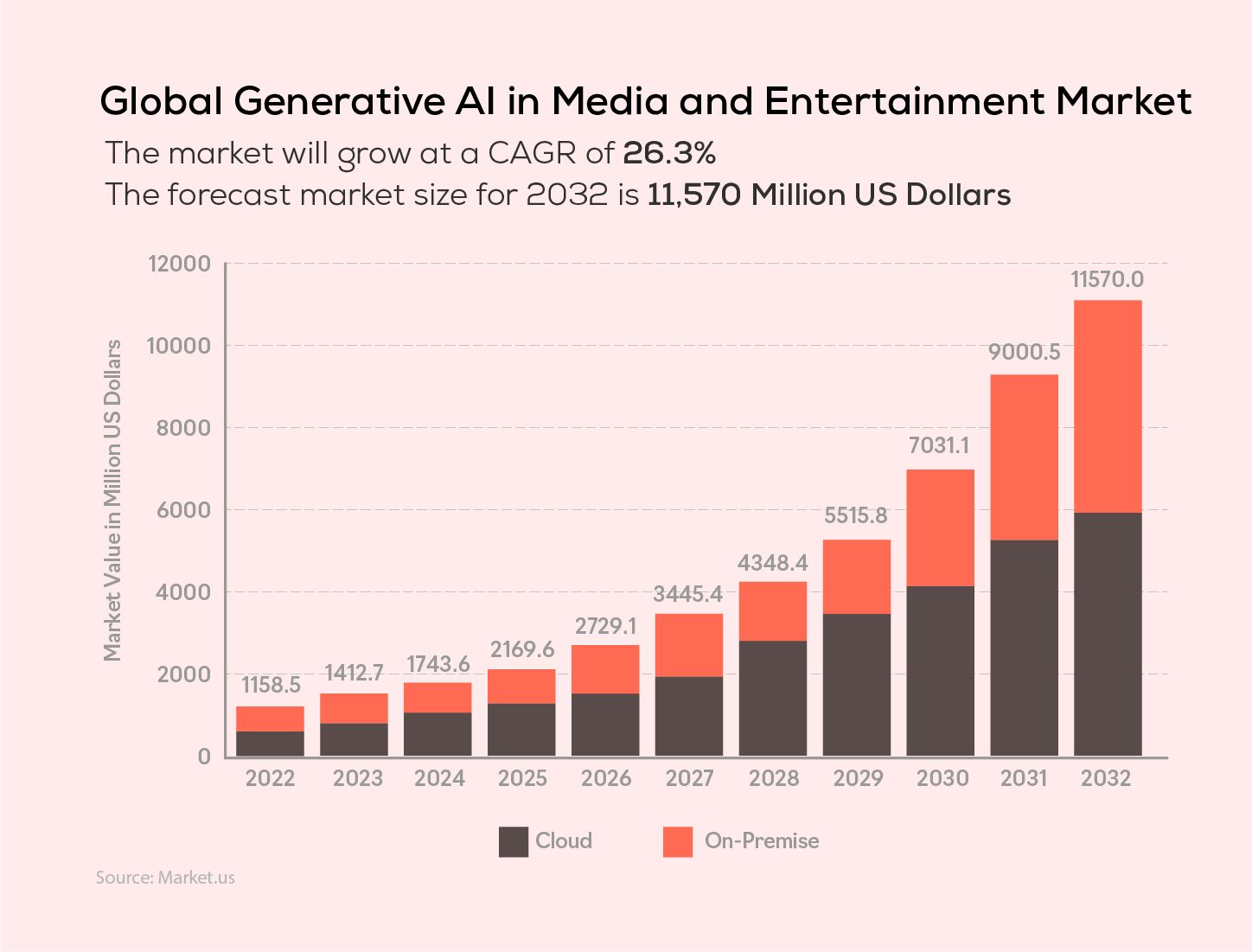
Example - Plask is an advanced technology used to generate 3D animations. With Plask, high-quality images can be created within minutes, saving time and effort. It can also be used to create realistic characters for gaming experiences and stunning animations for movies, TV shows, and advertisements.
5. Medical Diagnostics and Pharmaceutical Discovery
Generative AI is transforming the field of medicine at an astonishing rate. AI-powered image editing is revolutionizing diagnostics, enabling doctors to zoom in on medical images and obtain clear, detailed views of what’s happening inside the human body. This leads to more accurate diagnoses and more effective treatments. Additionally, generative AI is revolutionizing drug discovery and design processes in the pharmaceutical industry. This technology helps scientists invent new drugs and identify hidden proteins with greater accuracy.
According to a survey by Precedence Research, the generative AI market size in 2022 reached USD 1.07 billion and is expected to reach approximately USD 21.74 billion by 2024, with a CAGR of 35.14%.
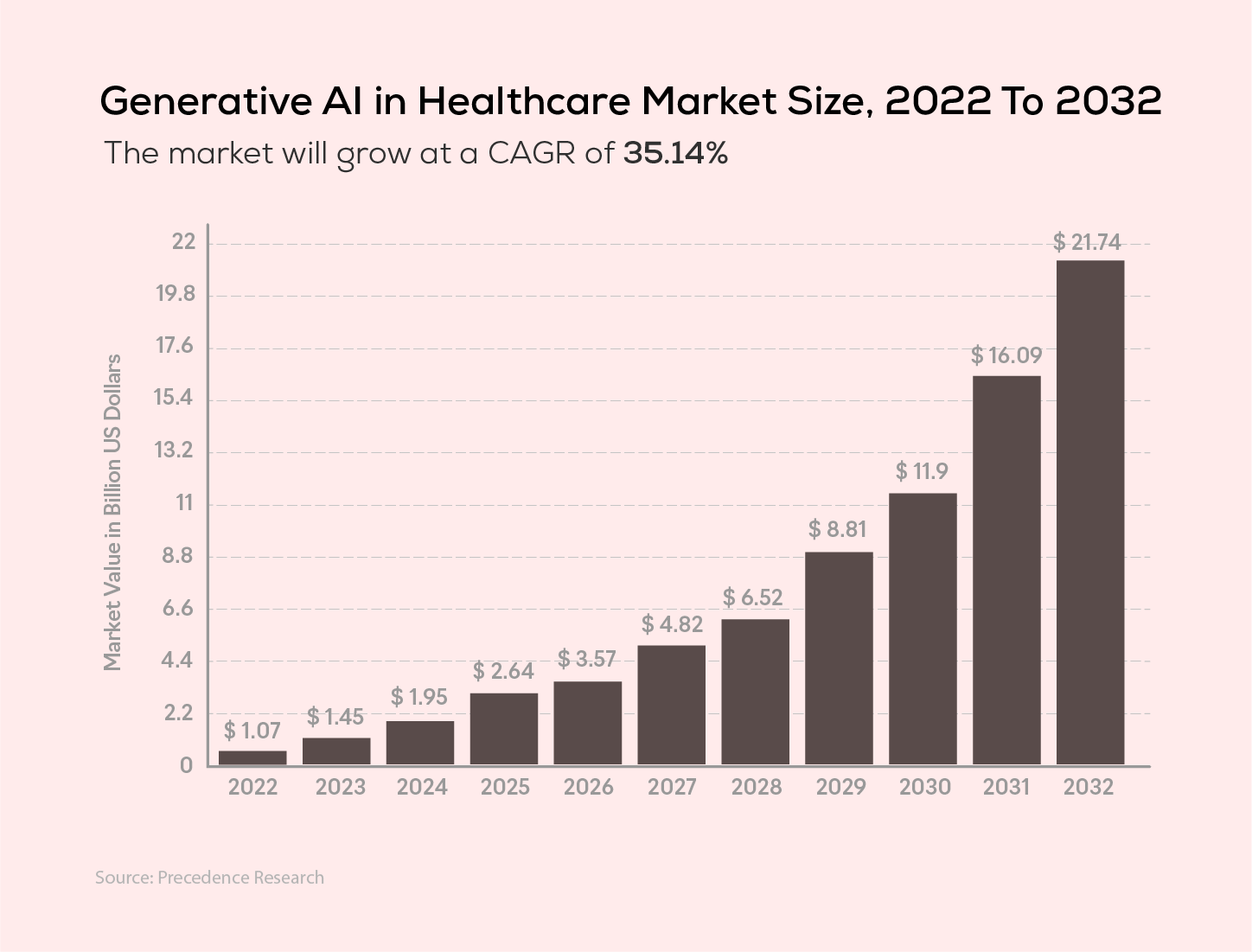
6. Fraud Detection and Risk Management
AI technology can detect fraud by analyzing vast amounts of transactions and claims, identifying unusual patterns. Generative AI processes massive datasets to uncover fraud, predict risks, and speed up loan approvals. This technology benefits insurance companies by making the claim process easier for both customers and insurers. It analyzes past policies and claims to streamline the process and helps create custom plans tailored to specific needs, speeding up the entire procedure.
Example - Simplifai InsuranceGPT is a GPT tool designed for insurance professionals. It offers advantages such as shortlisting similar cases from historical databases, automatically searching for information, and reading and writing cases and documentation.
7. Smart Manufacturing
Generative AI technology aids design teams in creating new products and maintaining smooth production processes. By analyzing sensor data, it generates to-do lists and provides real-time performance data, empowering both engineers and frontline workers. This technology optimizes opportunities and highlights key data points to enhance productivity.
Example - Clarifai is a powerful tool that offers several advantages, including the fastest path to actionable insights, pre-trained models, and the ability to be deployed anywhere. It is a versatile tool for building AI applications without requiring development skills.
8. Travel and Hospitality
How would you feel if someone could plan your entire trip? Well, now you have that with generative AI tools! These tools assist travel planners by offering recommendations and suggestions for travel expenses and lodging, finding flights and hotels, booking live events, setting time frames for each destination, and more.
Example - Roam Around allows planners to modify trip plans easily. Users can enter a destination and receive a list of popular locations in that area. It also suggests hotels for accommodation and has the option to generate photos to view the locality. Additionally, Roam Around provides links to hotels, food options, transportation, parks, museums, and medical services, ensuring a comprehensive travel planning experience.
Popular Generative AI Tools
Across industries, artificial intelligence is rapidly transforming operations with innovative applications emerging in various fields. This powerful technology is changing the way things work and is experiencing exceptional growth. It goes beyond innovation, setting the stage for creativity. Generative AI tools process information and learn from it, enabling them to produce human-quality content, from text and music to images and videos.
Let’s uncover some popular generative AI tools in detail:
1. Tools for Writing
1.1. ChatGPT
One of the most popular and widely used writing tools, ChatGPT, is known for producing human-like text. This user-friendly tool allows users to type a question or prompt, and the system generates results. Its natural language processing abilities enable it to understand the question and provide specific responses. ChatGPT creates a conversational setup that helps generate written content such as essays, articles, stories, emails, social media captions, code, and more. ChatGPT has over 180.5 million monthly users and 100 million weekly active users. Can you guess the projected revenue for ChatGPT in 2024? It is forecasted to generate $1 billion in 2024. Yes, you heard it right!
Pros :
- 24/7 Support
- Multilingual Communication
- Scalability
Cons :
- Dependency on Technologies
- Spreading misinformation
- Inability to multitasking
1.2 Bard
Bard is a conversational AI built on Google’s PaLM2 large language model, designed to assist with various tasks. Depending on the content's need, Bard responds in text, video, or image format. It provides users with three different detailed responses, offering a comprehensive approach to information retrieval. Recently, Google has made significant advancements in Bard, transitioning it into a new iteration known as Gemini.
The updates in Gemini go beyond text processing. It can now create visual content, such as images and videos, and provide a variety of suggestions to help users understand complex concepts by breaking them down into simple language. This enhancement makes Bard not only a powerful text-based AI but also a versatile tool for generating and understanding visual content.
Pros :
- Provides a range of formats and styles
- Human-Like conversation
- Voice command support
Cons :
- Inaccuracy
- Limited Responses
- Lack of Real-World Knowledge
1.3 Copy.ai
Whether you need blog posts, social media captions, or emails, Copy.ai is here to help. Users can save time and effort by simply providing prompts for the required materials. Built on OpenAI’s GPT-3 large language model, Copy.ai offers a user-friendly platform that supports content creation in over 25 languages, making it accessible even to beginners.
Do you need a blog intro, social media content, a Facebook headline, or a product description? Copy.ai provides templates for all these needs! Additionally, it offers plagiarism checks to ensure the originality of your content. This versatile tool is designed to make content creation quick, easy, and reliable.
Pros :
- Consistency and Accuracy
- Generates large amounts of texts
- Unlimited Characters
Cons :
- Generation of inaccurate content
- Proper fact-checking is required
- Appearance of random contents
2. Tools for Image Generator
2.1. Canva
This user-friendly platform allows you to create stunning visuals for various marketing needs, from social media posts to engaging presentations. Canva offers a massive collection of free images that bring your ideas to life. Its pre-made templates spark creativity and save time for designers. Here are a few things you can create with Canva: presentations, resumes, social media posts, logos, posters, brochures, certificates, newsletters, calendars, banners, and more.
Additionally, the platform's user-friendly 'drag-and-drop' feature makes it easy to use. Within just a few clicks, images and videos can be seamlessly integrated into your presentations. When you browse through Canva, you'll find more than 50,000 templates ready to use, edit, and modify to suit your needs.
Pros :
- User-friendly Interface
- Availability of Free Version
- Regular Updates and Additions
Cons :
- Storage Limitations
- Dependency on Internet Connection
- Limited Font Customization
2.2 Jasper Art
This tool uses AI to create pictures based on your descriptions. Jasper employs artificial intelligence technology to generate unique and original images from your ideas. Whether you envision simple sketches, detailed paintings, or stunning 3D animations, Jasper can turn your dreams into reality. It converts your text into AI-generated images, producing unique visuals perfect for social media posts, blog content, and emails. Additionally, Jasper utilizes DALL-E 2 to create these unique images.
Pros :
- No restrictions for the image limit
- Allows to create images based on various style
- Generates ideas into reality
Cons :
- May not be 100% accurate
- Sample image for reference cannot be added
- Prompts must be given to describe in words
2.3 Deep Dream Generator
Developed by Alexander Mordvintsev, this Google tool is an AI image generation platform that creates mind-blowing images based on simple descriptions. It allows users to describe an image and transform it into artwork instantly, sharing it easily with others. Digital artists can create stunning visuals, unique backgrounds, and bring designs to life. Marketers can generate eye-catching visuals to capture audience attention for social media campaigns, and photographers can apply surreal and dreamlike effects to enhance their works using deep dream generators.
Pros :
- Easy to use
- Free Trail
- Generates photorealistic images
Cons :
- Too Pricey
- A Paid Plan is required to use the images
- Doesn’t understand the prompts well
3. Tools for Image Generator
3.1. Landr
This platform utilizes AI-powered technology to deliver high-quality sound results and fine-tune audio at affordable prices. Its advanced tools provide precise control over sound, ensuring customer satisfaction. Did you know? Landr is widely used by megastars like Lady Gaga, Seal, and Snoop Dogg. The remarkable precision of its AI tools adds significant value.
Landr features a drag-and-drop option that makes it easy to use and master tracks. It's a powerful tool for sound engineers and producers, combining the precision of AI with advanced editing capabilities to give you complete control over your final sound. Additionally, your preferred music can be distributed and stay online on popular platforms like Apple Music, Tidal, Spotify, and iTunes.
Pros :
- Collaboration and Networking
- Free sample packs
- Distribution
Cons :
- Limited mastering options
- Lacks human interaction
- Limited number of tracks
3.2. Adobe Audition
This software, included in the Adobe Creative Suite, is a favorite among professionals. It offers a comprehensive set of tools for editing, mixing, and creating high-quality content. This tool is highly favored by audio engineers, musicians, podcasters, and video editors. Its user-friendly interface allows users to achieve high-quality sound effortlessly.
Moreover, this industry-standard software goes beyond simple enhancement. It empowers professionals with a complete suite of tools for sound enhancement, audio engineering, and music production.
Pros :
- Expands your creativity skills
- Helps to polish every track
- Opens opportunities for complex editing projects
Cons :
- Takes time to adapt
- Too pricey
- Availability of limited features
3.3. Mubert
Who doesn’t love discovering a tool that brings a musical flair to life? Enter Mubert! Mubert not only produces audio but also generates music, offering a comprehensive suite for music creation. It provides free music, a music program extension, and various music creation tools. To simplify the creative process, Mubert offers 100 different genres, helping you find the perfect track.
Pros :
- Track, Loop, Jingle and mix generations are available
- Prompt-based generation
- Adobe Plug-In
Cons :
- The unique features don’t satisfy all the customers
- Expensive
- You don’t get the option to buy additional credits for generation
Benefits of Generative AI
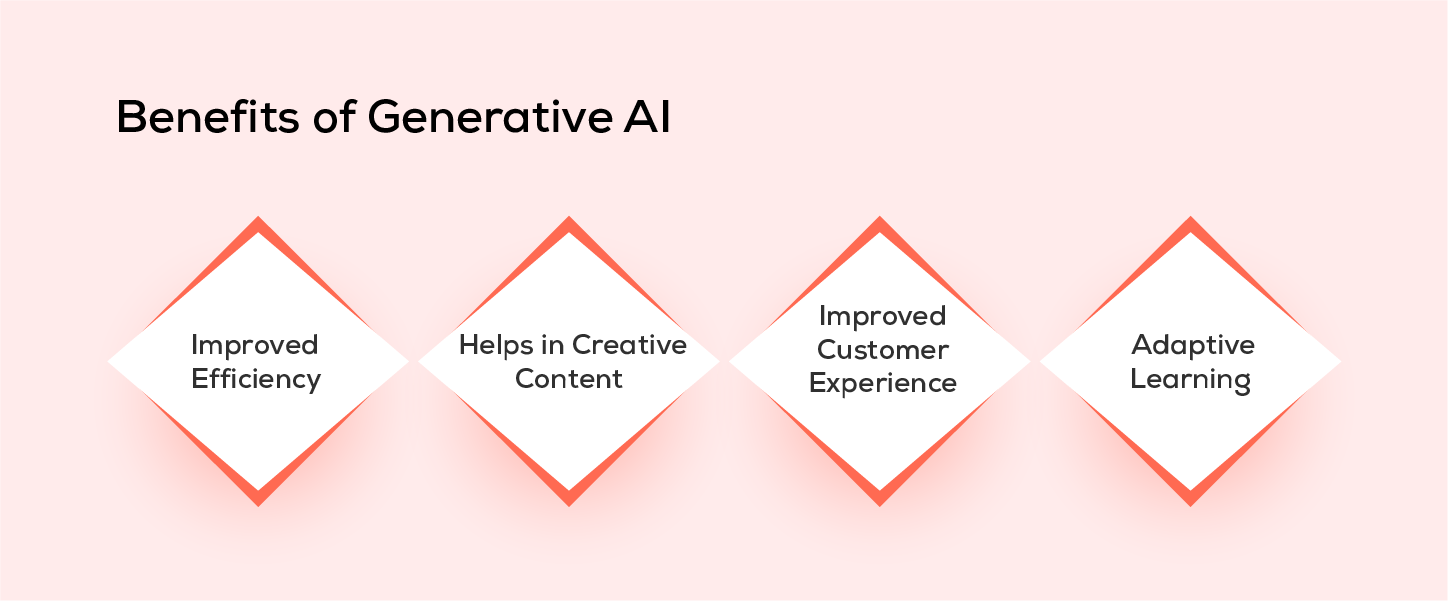
1. Improved Efficiency
Implementing generative AI in businesses automates complex processes and saves time, thereby improving efficiency. For example, with the execution of AI, marketers can plan their campaigns in just seconds, allowing them to focus on strategy and creativity instead of repetitive tasks.
2. Make creative content
Language models like GPT are trained on vast datasets and can create creative content such as poems, stories, novels, and quotes. These models add a touch of creativity to your work, enhancing both the quality and originality of the content produced.
3. Improve Customer Experience
Generative AI is becoming a top priority for businesses and significantly enhances customer experience. These AI agents provide human-like responses that foster business growth. They utilize NLP to address customer queries effectively and improve the overall quality of conversations.
4. Adaptive Learning
Generative AI models adapt to user feedback and provide new data, allowing them to generate more outputs over time. This iterative process leads to better results and a more satisfying user experience.
Recent Developments in Generative AI
In recent years, Generative AI has experienced significant growth in development, reshaping the constantly evolving field of artificial intelligence. Let's now explore the recent developments in Generative AI.
1. Dream Control
Prophetic, a tech startup, recently announced a headband called “the Halo” that aims to induce lucid dreams using “Morpheus-1”, an AI platform. This headband uses brainwaves and sound waves to monitor the brain's lucid dreaming. This device employs an electroencephalogram (EEG) to monitor the brain waves. However, experts have raised concerns about the potential long-term effects of using such headbands.
2. AI Image Generator
A new AI tool called KOALA, has been developed by South Korean Scientists to generate images without the use of expensive hardware. For faster speed and wider accessibility, scientists decreased the giant Stable Diffusion XL model to the nimble KOALA. These 700 million parameter models run smoothly on affordable GPUs with just 8GB of RAM. It generates an image in just 1.6 seconds and the team plans to use this in various applications including education, content production and image generation services.
Impact of Generative AI across Various Industries
The arrival of Generative AI is booming across various creative industries and creating incredible opportunities for humankind. As advancements in these technologies continue to grow, we can witness their potential to transform industries. Explore the influence of Generative AI across diverse industries.
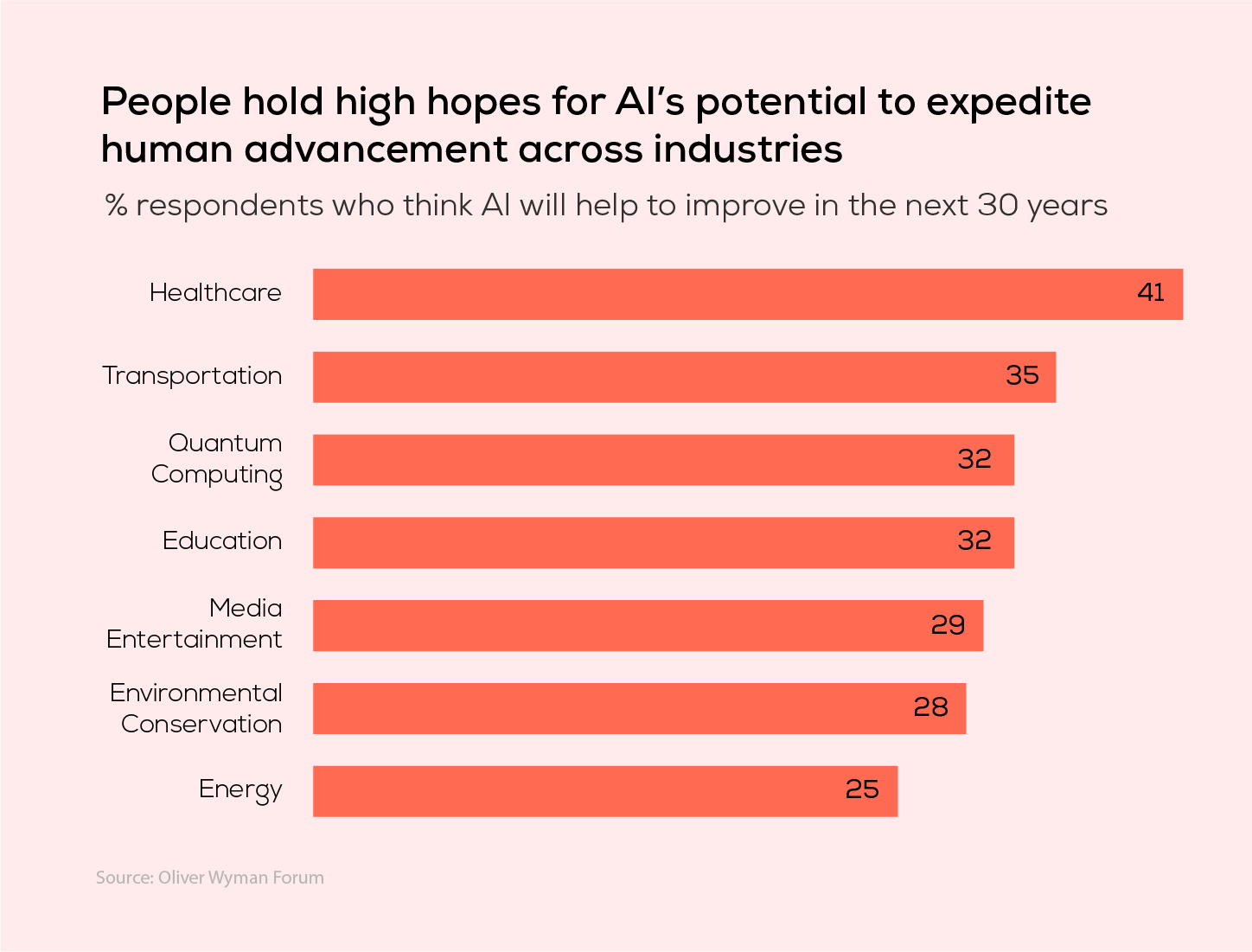
Having explored the potential of generative AI, let's shift into the world of machine learning and witness how it is taking shape in the digital world.
What is Machine Learning?
In the age of digital transformation, it is crucial to recognize the importance of staying ahead. One of the foremost technologies leading this charge is machine learning (ML). Machine Learning is a potent tool within artificial intelligence that enables computers to learn and enhance autonomously through data utilization. It involves creating robust tools that empower computers to analyze data and make decisions independently. The capability to learn and improve from data renders ML versatile, addressing a wide array of challenges and driving technological advancements from voice assistance to self-driving cars.
Did you know? The machine learning market was valued at $72.17 billion in 2022 and is projected to reach $528.10 billion by 2030, growing at a compound annual growth rate (CAGR) of 18.73% from 2023 to 2030.
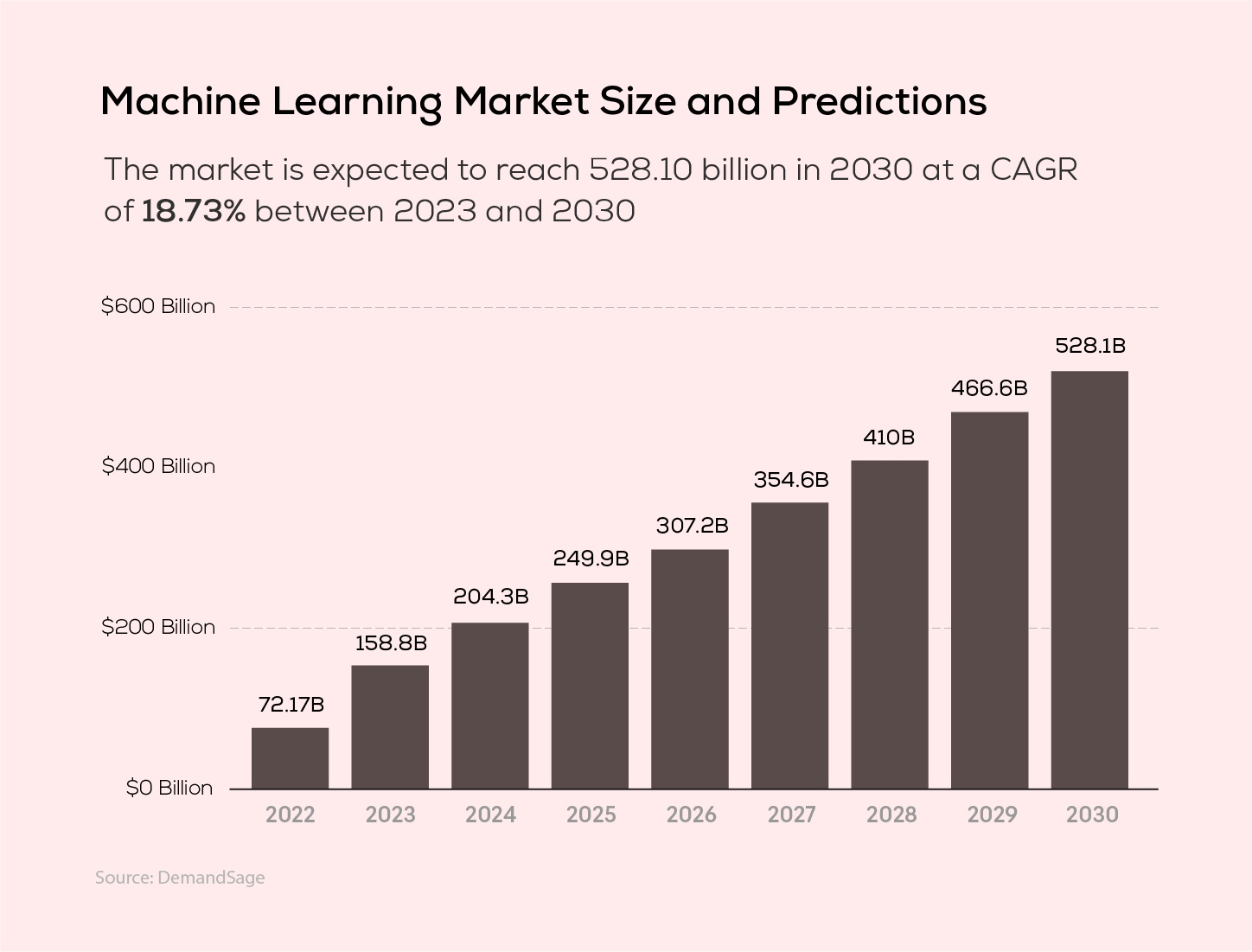
How does Machine Learning work?
Machine learning operates through various algorithmic techniques, primarily classified into three main approaches: supervised learning, unsupervised learning, and reinforcement learning. These techniques involve the application of one or more algorithms designed to detect trends, recognize patterns, categorize data into groups, and make informed decisions. Algorithms can function independently or collaboratively to achieve higher accuracy. Here is an overview of the machine learning working process.
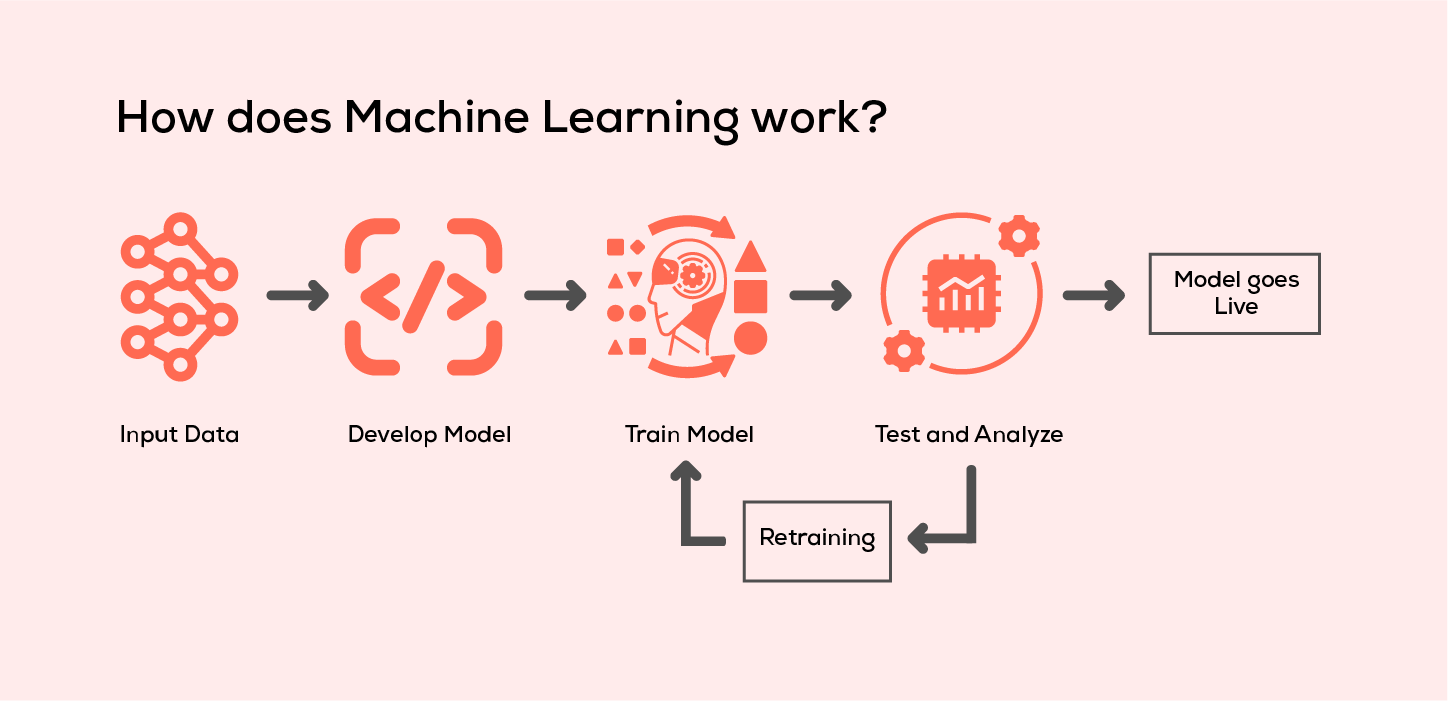
Different Types of Machine Learning Process
The machine learning process operates through a variety of algorithms and techniques tailored to different types of machine learning:
- Supervised Learning
- Unsupervised Learning
- Reinforcement Learning
1. Supervised Learning
Supervised Learning is a branch of artificial intelligence and machine learning. The key to supervised learning is labeled data, which trains algorithms to categorize information or make accurate predictions. Applications of supervised learning include real-world uses such as traffic analysis, product recommendation engines, and sorting spam emails into different folders.
2. Unsupervised Learning
In this learning process, machine learning algorithms analyze unlabelled datasets to discover hidden patterns and group data autonomously, without human guidance. Common applications include market research, cybersecurity, face detection, gene sequence analysis, and image recognition.
3. Reinforcement Learning
Here, machines are provided with input data and tasked with identifying connections among various outcomes. Instead of providing direct answers, they derive sets of rules, actions, and objectives. Machines learn from experience when algorithms are predefined. Examples include automated price bidding, game development, and stock market trading.
Real-Life Use Cases of Machine Learning
Whether you notice it or not, machine learning processes occur daily. It's fascinating to observe the changes machine learning brings into our lives, streamlining business operations across various sectors. Here are some real-life use cases of machine learning processes.
1. Facial Recognition
Who doesn’t use facial recognition to unlock their mobile phone? Most of us rely on this efficient and advanced technology. However, how many of us realize that facial recognition is rooted in the machine learning process? Gone are the days of manual tagging for unidentified faces in photos. Today, facial recognition can instantly tag and verify people by analyzing facial features for identification and accuracy. Applications of facial recognition include:
- Automobile Security
- Access Control
- Immigration
- Education
- Healthcare
2. Fraud Detection
Fraud detection involves identifying scams and thwarting fraudsters from obtaining money through illicit means. Machine learning technology proactively detects such threats to prevent significant losses. One effective solution to combat this challenge is through credit card fraud detection. Deep learning, coupled with Python and R, can be utilized to develop advanced tools that preemptively thwart fraud.
3. Email Monitoring
Emails are widely used for both personal and professional communication but also present avenues for cybersecurity attacks. However, these attacks can be detected early through real-time email automation. NLP is a powerful tool for analyzing emails before they reach the inbox. Additionally, anomaly detection using machine learning is effective for identifying threats. The combination of NLP and anomaly detection serves as a solution to detect and mitigate these issues.
4. Self-Driving Cars
The technological landscape has witnessed significant changes, and the evolution continues. Self-driving cars made a major leap in 2020, exemplified by companies like 'Waymo One' offering customers their first experience of driverless taxis. These cars utilize sensors to gather information from the environment. They are equipped with reliable cameras, radar detectors, laser focus, microphones, and Lidar. The features of these cars include:
- Ability to identify routines
- Detect the front car distance
- Road-marking detection
- Automated parking
5. Skin Cancer Diagnosis
The healthcare industry demands technology capable of delivering accurate results. Deep Learning tools such as Convolutional Neural Networks (CNNs) have achieved up to 95% accuracy in detecting skin cancer through platforms like TensorFlow. Other machine learning tools such as Keras and Scikit-learn complement these advancements.
6. Social Platform Recommendations
Social media platforms play an important role in understanding how machine learning has become essential. How many have you come across ‘People you may know’ when you scroll platforms like Twitter, Facebook and Linkedin? These platforms employ machine learning algorithms to suggest profiles based on your current connections, interests, and other factors.
7. Transportation
The transportation industry has seen significant advancements in the past decade, with services like Uber, Ola, and Lyft gaining popularity. A prime example of machine learning in this field is Google Maps, which offers features such as route suggestions, estimated travel times, real-time traffic updates, and nearby location exploration.
Recent Developments in Machine Learning
Major advances continue to drive the machine learning sector, offering new perspectives on technological advancements. Let us now delve deeper into the recent developments in machine learning.
1. Anti-Ageing Research
The University of Edinburgh has recently discovered a new anti-ageing medicine known as senolytics, which slows down the ageing process and prevents health issues. The team employed machine learning to effectively recognize senolytic compounds. This method aims to streamline the identification process, which traditionally could be slow and expensive. The testing process targets both healthy and ageing cells, revealing three promising molecules while sparing normal cells. Additionally, researchers believe these approaches could also be applied to cancer treatment and drug discovery.
2. New Brain-Like Transistor
Scientists have recently developed a human-like transistor capable of imitating and storing information. Known as a 'synaptic transistor', it offers both speed and energy efficiency. Constructed from layers of graphene and boron nitride, this transistor operates at room temperature. It has demonstrated capabilities such as associative learning and holds promise for advancing AI systems in the future.
Benefits of Machine Learning
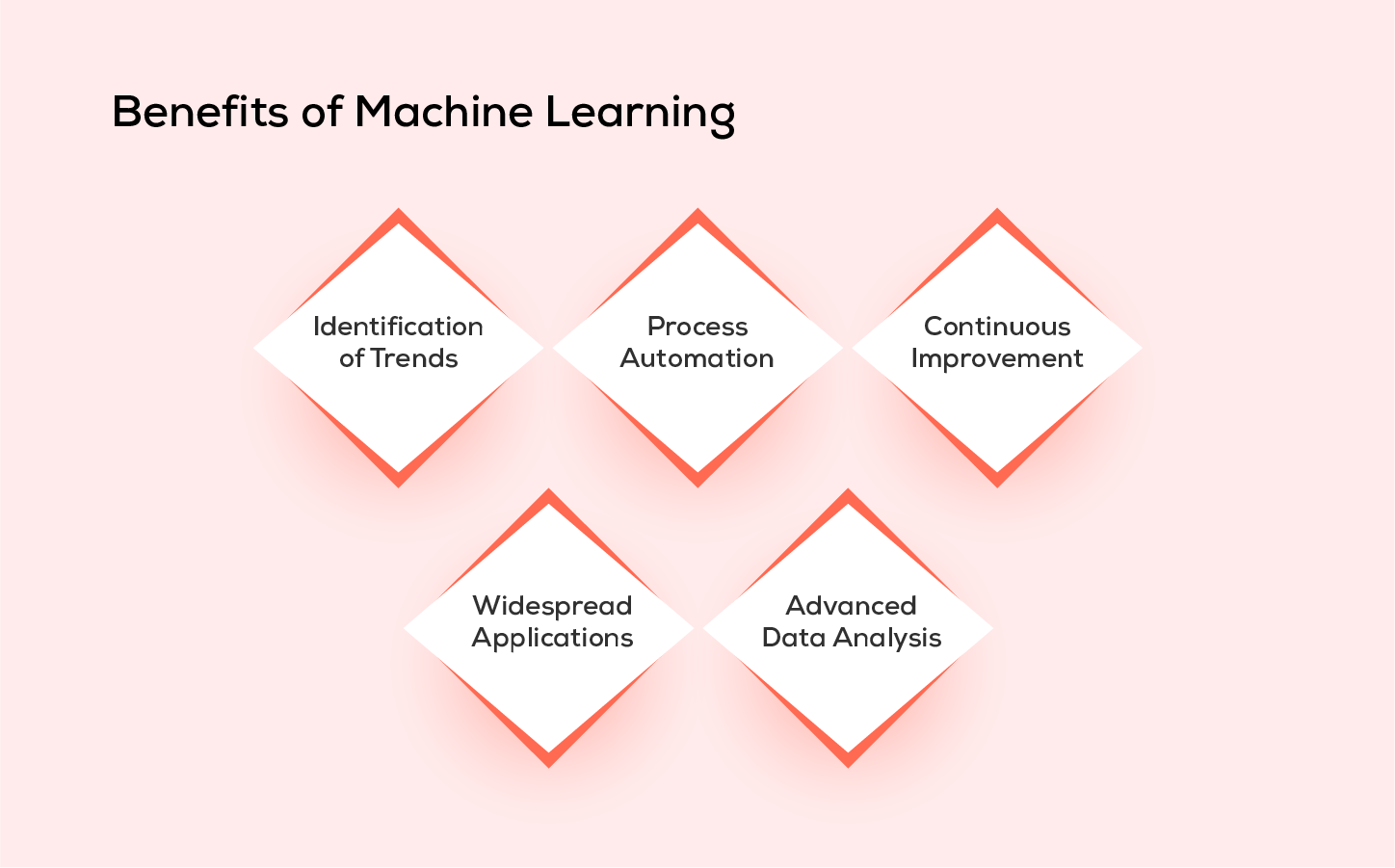
1. Identification of Trends
The primary benefit of machine learning technologies is their ability to identify data and trends that may be difficult for humans to spot. By efficiently interpreting datasets, ML models can logically analyze data to derive insights, thereby enhancing efficiency and identifying trends effectively.
2. Process Automation
Machine Learning automates numerous tasks, facilitating AI model training and automating data analysis. Supervised machine learning involves human involvement, while unsupervised learning and reinforcement learning enhance predictive accuracy and strengthen ML models.
3. Continuous Improvement
Machine Learning algorithms indeed learn and improve over time through continuous learning, which enhances their accuracy, efficiency, and decision-making capabilities. For instance, in a weather forecasting model, as the algorithm gathers more data and learns from it, it becomes faster and more accurate in making predictions.
4. Widespread Applications
The major advantage of Machine Learning lies in its wide-ranging applications across various fields such as healthcare, marketing, finance, and transportation. These applications span from fraud detection and security to self-driving cars, price prediction, and personalized experiences in music, video, and audio.
5. Advanced-Data Analysis
Machine Learning excels at comprehending complex data types such as audio, images, and written texts. Techniques like natural language processing and computer vision enable the discovery of hidden patterns within any form of information.
The Future of Machine Learning
Machine Learning is once again raising the bar!
It has the potential to revolutionize every sector of industry and benefit society at large. Machine Learning offers advantages to organizations across the spectrum, from multinational corporations to startups and government offices, by automating manual tasks. As technology continues to advance, companies like Google, Facebook, and Twitter are increasingly hiring employees with deep knowledge of machine learning. Machine Learning algorithms analyze vast amounts of data to optimize workflows across various industries. Here comes the future of Machine Learning!
Exploring the Difference Between Artificial Intelligence and Machine Learning
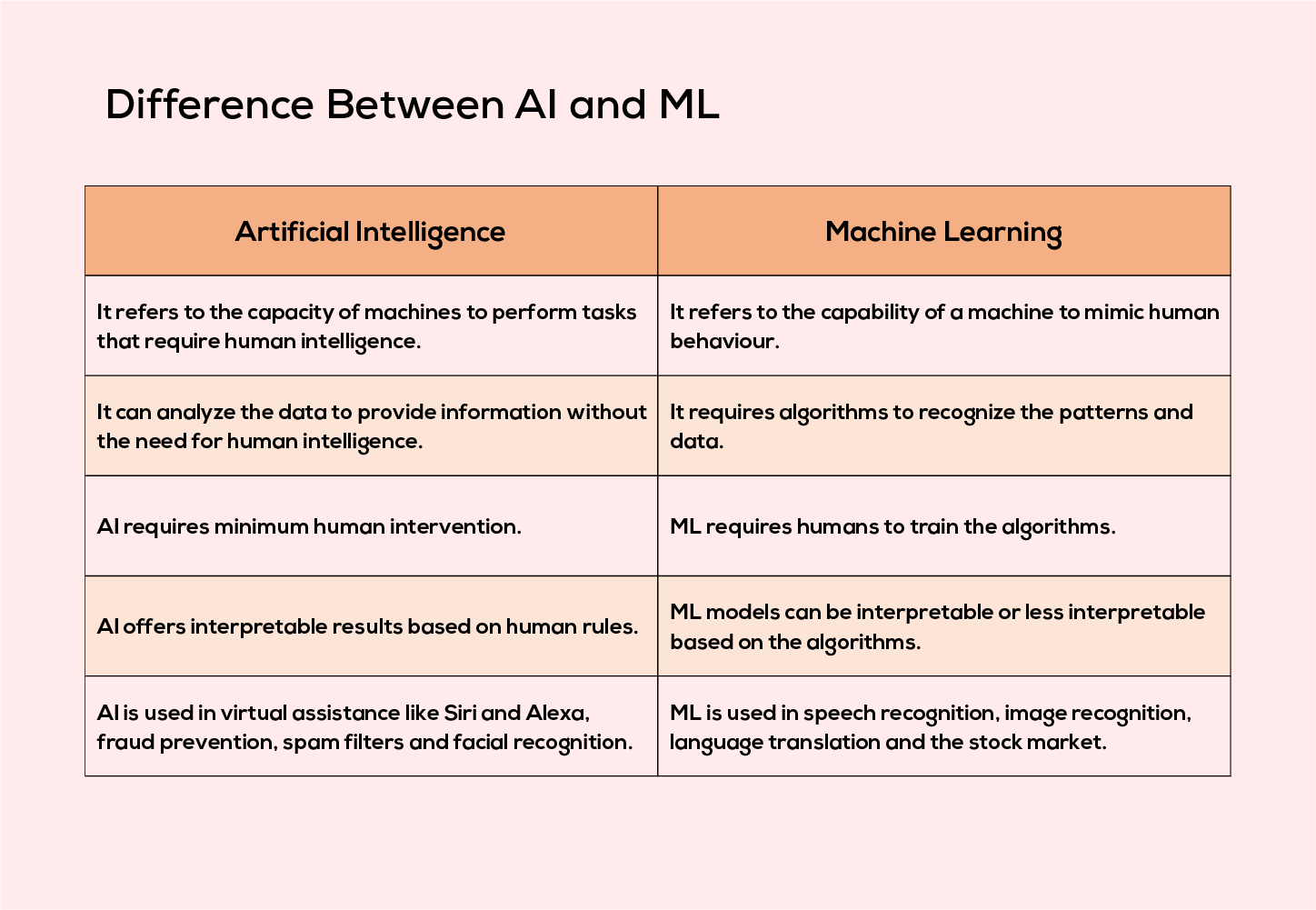
Final thoughts
AI and ML are powerful tools shaping our lives, and their significance soon is unquestionable. In the coming years, their growth is witnessed at an unprecedented rate. They are revolutionizing industries and solving complex problems. The future of AI and ML is constantly evolving, transforming every aspect of our lives and promising continuous innovation and improvement.
Frequently Asked Questions
1. What are the emerging trends in AI?
No-Code Machine Learning, AutoML, Full Stack Deep Learning, TinyML, Generative Adversarial Networks and so on.
2. Can Generative AI be used for anomaly detection?
Yes, Generative AI can indeed be used for anomaly detection. Anomaly detection involves identifying patterns or instances in data that deviate from what is considered normal or expected. Generative AI models, such as GANs and autoencoders, are particularly effective in this field due to their ability to learn the underlying distributions of data.
3. Can Generative AI be used in art and creativity?
Natural Language Generation (NLG), a type of AI can create human-like text and is being used to generate everything from creative writing to poetry and literature. Next, come chatbots and virtual assistance. They use programs to have conversations and assist you. Chatbots are being used in museums and galleries to exhibit creativity.
4. Is Machine Learning the future of AI
Advanced machine learning techniques pave the way for various applications. The primary goal of machine learning is to achieve learning, reasoning, adapting and understanding various domains.
5. What role will Generative AI play in the future?
It will play an important role in healthcare innovation, climate modelling, improved realism, industry applications and personalized content.


